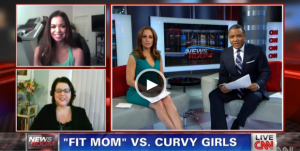The incident where Maria Kang was briefly kicked off of Facebook, recent news about the “lower” rate of obesity among Asian Americans, and the debate on CNN above combine to bring up a subject that isn’t often discussed: health vs appearance. Is someone who is skinny necessarily fit? Is someone who is not so lean necessarily unfit? While I don’t doubt that Maria Kang is very fit, Asian American Pacific Islander (AAPI) appearances can be deceiving with regard to health.
 Research on Asian Pacific Islander BMI and waist circumference demonstrates that these standards, which often match appearances of fitness, are deceiving. Just because an AAPI doesn’t look fat doesn’t mean that they are fit and not vulnerable to heart disease – the standards for some Asian ethnic groups are lower than for whites. By the same token, just because some looks bigger doesn’t mean that they are not fit. Measures like BMI and height/waist ratio vary greatly, with Pacific Islanders having a much less stringent standard for being healthy. The LA Times article gets some things wrong – some Asian Americans can still have a BMI under 25 and under the Asian BMI standards, be overweight.
Research on Asian Pacific Islander BMI and waist circumference demonstrates that these standards, which often match appearances of fitness, are deceiving. Just because an AAPI doesn’t look fat doesn’t mean that they are fit and not vulnerable to heart disease – the standards for some Asian ethnic groups are lower than for whites. By the same token, just because some looks bigger doesn’t mean that they are not fit. Measures like BMI and height/waist ratio vary greatly, with Pacific Islanders having a much less stringent standard for being healthy. The LA Times article gets some things wrong – some Asian Americans can still have a BMI under 25 and under the Asian BMI standards, be overweight.
It’s worth mentioning that other conditions are important to health and the ability to look lean and cut.
After giving birth to a child, MMA fighter Michelle Waterson couldn’t get her weight down to close to her fighting weight no matter hard she tried worked out. She was fit, but she had a thyroid condition that stopped her from getting down to a lean fighting weight. One of the biggest correlations to obesity, especially for women, is income (although that correlation has been steadily weakening). Healthier food is often more expensive than unhealthy food, and if you can’t afford join a gym, staying healthier becomes harder.
I’d say an approach that encourages improvement of fitness, rather than focusing on attaining a look that may or not be healthy or even necessary for some, is a better way to go. Shaming approaches can backfire – just like telling your kids to do one thing means that they will do the opposite. Maria Kang’s recent discussion about the “wrong message” that plus size lingerie sends ended up increasing business for Chrystal Bougon’s shop that specializes in that lingerie for bigger women (a more cynical person might suggest that this was an intentional publicity win-win for both Bougon and Kang) . Another approach is providing ways to support people’s desire to change, as with Karen Cheng’s 100 days platform. This video of one woman’s efforts to exercise and lose weight (shown embedded below) is inspiring and positive.
While many people are eager to bash Maria Kang, I personally think she really wants to help people improve their health. Some of her latest work makes it seems like that she seems to have figured out some of what I just discussed. Her 2014 calendar shows people who have made fitness improvements and who don’t look like fitness models. She seems to understand the income issue, setting up a foundation, Fitness Without Borders, that says it works mainly in underprivileged neighborhoods.
At the end of the “debate” on CNN between Bougon and Kang, the question about appearances and health does come up. Bougon says that you never can tell, while Kang says that you always can tell. I’d say that the truth, especially for AAPI people, lies somewhere in between.
http://www.youtube.com/watch?v=I5FkshLcNLQ








